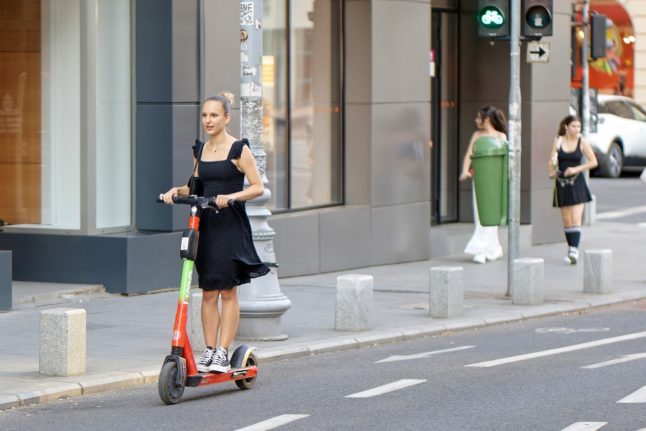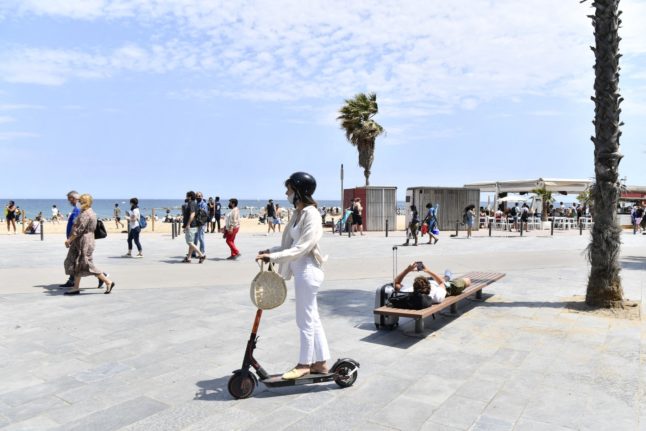Most Spanish cities do not plan to hold a referendum like the one held in Paris but prefer to create more rules and regulations instead.
The general director of Spain’s General Directorate of Traffic (DGT), Pere Navarro, sees it necessary to influence the regulation of electric scooters while warning of “an excessive prohibitionist era”.
The current Personal Mobility Vehicle (MVP) rules (including for electric scooters) as outlined by the DGT are:
- You must drive carefully, avoiding endangering other road users
- You must not drive on the pavements: it is prohibited
- You must respect the signs and pedestrian crossings
- You must not ride with headphones in: in addition to being very dangerous, it is prohibited.
- Only one person is permitted to ride on a scooter at a time
- You must wear a helmet
- You are only allowed to park in the authorised places, as directed by your municipality
- The person responsible for any incident is the driver, or their parents, if they are a minor
- The minimum age requirement to ride a VMP is 16
- VMPs are not allowed on interurban roads, highways, highway crossings and urban tunnels
READ ALSO – Electric scooters in Spain: What are the rules and latest changes?
Although these are the general rules, each city or municipality in Spain has its own regulations when it comes to scooter rentals and how they are managed. We have listed the rules for some of the main Spanish cities below.
Madrid
The mayor of Madrid, José Luis Martínez-Almeida, made it clear that he will not let the future of electric scooter rental be decided by a vote, but is committed to once and for all regulating their use.
The City Council has made steps to implement a “more orderly, safe and integrated” shared micro-mobility model. Scooters, for example, must include GPS to locate those that are not parked correctly.
According to city hall figures, last year 94,927 fines were issued against shared scooters, mainly for being parked incorrectly.
To solve this situation, on May 2nd a new fleet of 3,000 scooters (expandable to 6,000) will replace the 4,800 that are there now. They will only be able to park in authorised areas inside the central district.
Barcelona
Barcelona City Council does allow companies to rent out electric scooters to tourists, but has regulated both parking and circulation areas. For example, in 2017, it prohibited the use of scooters in the Ciutat Vella or Old Town.
In 2019, the city announced they would introduce new regulations for shared electric scooters saying that they had to be rented per minute like bicycles and motorbikes in order to keep companies in check. They also introduced a limit to the number of scooters that can operate in Barcelona and the number of companies that can rent them out. There are still talks, however, about new legislation.
The council has introduced fines for parking in the wrong spots and riding in areas where it’s not allowed. The city council also prohibited electric scooters on public transport from February 1st 2023.
Valencia
While you can rent electric scooters from certain companies in Valencia, in 2019, the city banned companies from allowing customers to book and rent scooters via mobile apps. This means that you cannot simply pick up a scooter to rent from the street or even a designated parking space, you have to go to the company premises instead.
The mayor of Valencia, Joan Ribó, has assured that this will continue and said: “Sometimes you can’t even walk down the street because they are all lying around”. Ribó celebrated the results of the Paris referendum and said that the French capital will begin to look more like Valencia.
Seville
In Seville, the City Council does not allow scooter rental companies to let their users park on public roads, not even in public parking lots. This means that to be able to use an electric scooter in this city you must park in a private parking lot.
The city has also recently prohibited electric scooters on public transport during rush hour.
Málaga
The Málaga City Council authorises a total of six companies to rent out scooters to tourists, which is an exceptional and temporary measure for 2023. These are Lime, Bird, Link, Dott, Bolt and Tier. They will be allowed to operate in the city with 225 scooters each.
This authorisation may be revoked or modified at any time for reasons of public interest without the owner being entitled to any compensation or indemnity.
Electric scooters in Málaga are not allowed on pavements or pedestrian areas, as established by the Mobility Ordinance. This means that companies are obliged to deactivate vehicles electronically through a geolocation system when any of them tries to enter a restricted area.



 Please whitelist us to continue reading.
Please whitelist us to continue reading.
Member comments